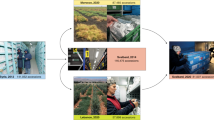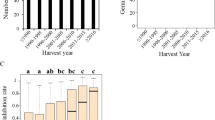Abstract
THE International Board for Plant Genetic Resources (IBPGR) is encouraging the development of an international network of seed banks for the conservation of the genetic resources of the major crop species of the world and their wild relatives1. Most of the species in priority lists show ‘orthodox’ seed characteristics2, that is their longevity is prolonged in a defined manner by a reduction in moisture content (MC) (at least down to 5% MC, fresh weight basis) and temperature3. From a consideration of biological factors and the design and cost of seed storage facilities, IBPGR recommends that orthodox seeds are stored at −18 °C or less and at 5± 1% MC2. It is convenient to aim at −20 °C as the nominal temperature. Because of the accumulation of mutations associated with loss of viability4,5, IBPGR recommends regeneration of stocks (that is growing plants to provide new seeds from the old) when viability has fallen by 5% (ref. 2). To plan ancillary facilities and procedures, it is necessary to estimate regeneration intervals (time taken for viability to fall by 5%) for the major crop species. Such estimates pose three problems: there are genotypically controlled variations in longevity within a species; seed ‘quality’, determined by conditions before harvest and during processing, can affect subsequent longevity; and loss of viability at −20 °C is extremely slow, and so far it has been possible to predict regeneration interval only by questionable extrapolation from more favourable storage conditions5,6. We have examined these problems in barley (Hordeum distichum, L.) and have developed an approach which should make possible more accurate predictions from experiments lasting only 2 yr—even though fresh seed of most species shows no detectable loss of viability during this time.
This is a preview of subscription content, access via your institution
Access options
Subscribe to this journal
Receive 51 print issues and online access
$199.00 per year
only $3.90 per issue
Buy this article
- Purchase on SpringerLink
- Instant access to full article PDF
Prices may be subject to local taxes which are calculated during checkout
Similar content being viewed by others
References
The Conservation of Crop Genetic Resources (International Board for Plant Genetic Resources, Rome, 1975).
Report of the IBPGR Working Group on Engineering, Design and Cost Aspects of Long-term Seed Storage Facilities (International Board for Plant Genetic Resources, Rome, 1976).
Roberts, E. H. Seed Sci. Techn. 1, 499–513 (1973).
Roberts, E. H., Abdalla, F. H. & Owen, R. J. Symp. Soc. exp. Biol. 21, 65–100 (1967). Abdalla, F. H. & Roberts, E. H. Ann. Bot. 32, 119–136 (1968). Abdalla, F. H. & Roberts, E. H. Ann. Bot. 33, 153–167 (1969). Roberts, E. H. Seed Sci. Techn. 1, 515–527 (1973).
Roberts, E. H. in Crop Genetic Resources for Today and Tomorrow (eds Frankel, O. H. & Hawkes, J. G.) 269–295, 316 (Cambridge University, Cambridge, 1975).
Roberts, E. H. in Viability of Seeds (ed. Roberts, E. H.) 14–58 (Chapman & Hall, London, 1972).
Ellis, R. H. thesis, Reading Univ. (1976).
A. Rep. Seventh Lab., Div. Genet., Japan 5–7 (1963) (in Japanese).
Roberts, E. H. Ann. Bot. 24, 12–31 (1960).
Roberts, E. H. & Abdalla, F. H. Ann. Bot. 32, 97–117 (1968).
Author information
Authors and Affiliations
Rights and permissions
About this article
Cite this article
ROBERTS, E., ELLIS, R. Prediction of seed longevity at sub-zero temperatures and genetic resources conservation. Nature 268, 431–433 (1977). https://doi.org/10.1038/268431a0
Received:
Accepted:
Issue date:
DOI: https://doi.org/10.1038/268431a0
This article is cited by
-
Vorarbeiten zur monographischen Darstellung von Wildpflanzensortimenten:Aegilops L.
Die Kulturpflanze (1980)



